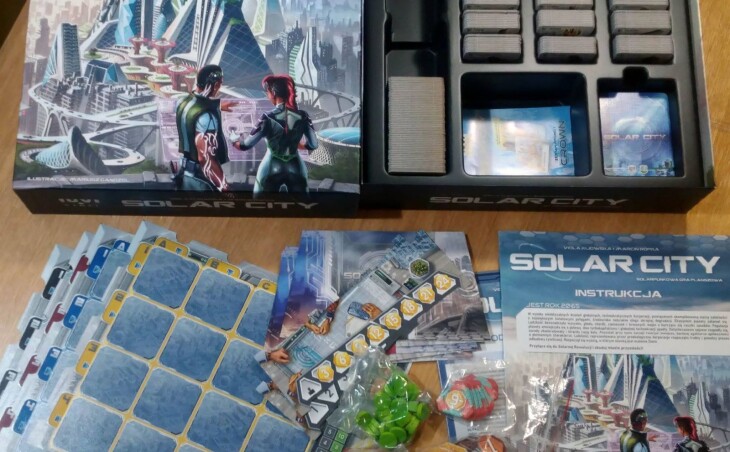Welcome to the city of the future – where skyscrapers are self-sufficient, ecological and zero-emission, and where parks and gardens are green on their top floors. This is the reality of solarpunk – a futuristic vision of the world in which, thanks to renewable energy, humanity has stopped climate change and lives in modern and clean megalopolises. In Solar City, we play the role of builders of utopian cities of the future and we try to outdo whose greener it will be by collecting Solar Points.
Green pulse of the city
During several rounds (5-9, depending on the number of players), we choose one of the three actions in turn: building a new skyscraper, building a public facility or upgrading a skyscraper to a sky garden.
The first two actions make our city grow wider: we add new building tiles to our board, divided into 16 fields. Skyscrapers generate E-credits income, the amount of which depends on the immediate surroundings of the constructed structure, its location in the city, or the presence of other structures. Public facilities most often improve the operation of the city in some way, e.g. by reducing the costs of building new skyscrapers.
The main way to earn victory points is to turn skyscrapers into sky gardens. We turn the selected tile of the skyscraper inside out and, interestingly, score for the opposite of the way in which we received money. For example: if a skyscraper generates income for empty spaces in a column or row, it will give you points for each occupied space as a sky garden. This perversity, coupled with the increasing cost of buildings, leads to difficult decisions about what to build and upgrade when.
When developing our city, we need to balance the pace of economic growth and the pace of the race to victory. The key to Solar City is the spatial planning of the city and the use of relationships between buildings. We will not build any mega combos in the game, but we can squeeze a few extra points from cleverly arranging the tiles.
Gardeners of a better tomorrow
As in many games with the common market, in Solar City the interaction between players results from the competition for skyscrapers available for construction. But not only. After adding the tile to the board, we activate the row or column in which it is located, disabling the possibility of reactivating it until the end of the round. We activate our own skyscrapers, but we also mix in our opponents’ plans. The other players also mark the activation of a given row or column, but without profiting from them. This puts pressure on us to use the city’s actions as quickly and efficiently as possible before our best buildings are locked.
By playing with more players, we will play more rounds, but we will activate fewer buildings in each. Then the balance of the tiles changes – what did great with the full line-up may be average when playing for two. The pleasure of the game, however, remains the same.
In addition, Solar City offers an interesting single-player variant that very much resembles a puzzle. The division into rounds disappears and we play until the entire city is blocked.
Horizon of concrete, glass and chlorophyll
The fully built-up city looks great. The graphics of skyscrapers and their improved versions make a particularly good impression – the sky gardens, which retain the elements of their predecessors, but change into modern, green architecture.
All game elements are of very good quality, the tiles and chips are solid, the cards are printed on decent paper. The only thing that bothers me is the thin charts of the cities – but here you can see that you could have either cardboard or prints with UV varnish and the publisher chose the latter solution. The box also includes curtains for players’ tokens – thin, but they fulfill their role – and a very comfortable molding, thanks to which we can quickly unfold and hide the game elements.
The tiles have action shortcuts with clear symbols on them, so a quick glance at the city reminds us of the possible effects of activating buildings.
A real urban jungle
There was a lot of confusion around the game related to the collapse of the publishing house that ran a community fundraiser. Fortunately, Solar City saw the light of day (nomen omen) thanks to the IUVI publishing house. Honestly – I didn’t expect much. Oh, we arrange the tiles, count the dots, and build the cities of the future. However, I was very positively surprised, because I got a well-thought-out, polished game in which both long-distance strategy and optimization of individual moves are important.
The game is a bit of solitaire and the construction of economic motors, but the interaction and blocking of other players is very important. There are as many as 18 types of skyscrapers in the basic box, but for one game we choose 6 of them, which on the one hand does not overwhelm, and on the other hand gives great possibilities of combining effects and introduces a lot of replayability.
There are a few small things that can be faulted, but for me they have little impact on the assessment of the game.
Definitely a good title.

